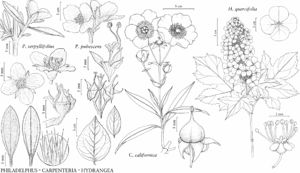Philadelphus serpyllifolius
Smithsonian Contr. Knowl. 3(5): 77. 1852.
Shrubs, 5–10 (–20) dm. Stems light reddish-brown, weathering gray and striate, stiffly divaricately to loosely branched, moderately strigose and appressed villous-sericeous; internodes (0.5–) 1.3–3 (–4.5) cm; short-shoot spurs sometimes present; axillary buds exposed. Leaves: petiole (1–) 2–4 (–5.5) mm; blade gray-white abaxially, green adaxially, lanceovate or oblong-ovate to broadly ovate, (0.5–) 1.2–2.5 (–3) × (0.2–) 0.4–0.8 (–1.4) cm, herbaceous to subcoriaceous, margins entire, plane, often drying revolute, abaxial surface sparsely to moderately sericeous-strigose, hairs ± appressed, coarse to slender, 0.6–1.1 mm, with dense understory of white, slender, curled-crisped hairs, adaxial surface sparsely to moderately sericeous-strigose, hairs scattered, appressed, coarse, 0.5–1.2 mm, (these (4–) 5–9 per mm of width in populations that have been called var. intermedius), also hirsute, hairs slender, usually erect, rarely appressed, 0.1–0.3 (–0.4) mm. Inflorescences: flowers solitary, produced from previous years long-shoots. Pedicels 1–2 mm, strigose-sericeous to villous. Flowers: hypanthium strigose-sericeous or villous; sepals ovate, 3–5.5 × 2–3.2 mm, apex obtuse, acuminate to ± caudate, abaxial surface strigose-sericeous or villous, adaxial surface sparsely sericeous but villous along margins; petals white, oblong-ovate to ovate, 4–9 (–11) × 3–6 mm; stamens 14–22; filaments sometimes proximally connivent, (1.5–) 2–4.5 mm; style 1, clavate, 2.4–3.2 mm, slender base 0.5–0.7 mm; stigmatic portion 1.3–1.7 × 0.9–1.1 mm, apex slightly lobed. Capsules turbinate-globose, 4–5.2 × 4–5 mm, sepals persistent on distal 1/3, capsule distal surface usually impressed in 4 (–8) vertical lines. Seeds not caudate, to 1.1 mm.
Phenology: Flowering Apr–Jun; fruiting May–Nov.
Habitat: Rocky igneous and limestone slopes, bluffs, pinyon-oak-juniper zones.
Elevation: 1100–1900(–2300) m.
Distribution

Tex., Mexico (Coahuila)
Discussion
In two populations of Philadelphus serpyllifolius from Brewster County (Glass Mountains, Sierra Madera), the adaxial leaf vestiture has both long and short appressed hairs (the shorter hairs not erect as in typical P. serpyllifolius). These populations also show variation in development of the understory of tightly coiled hairs on the abaxial leaf surface, with some collections lacking the understory of coiled hairs. These have been recognized as var. intermedius.
Selected References
None.
Lower Taxa
"connate" is not a number. "distinct" is not a number."dm" is not declared as a valid unit of measurement for this property.
